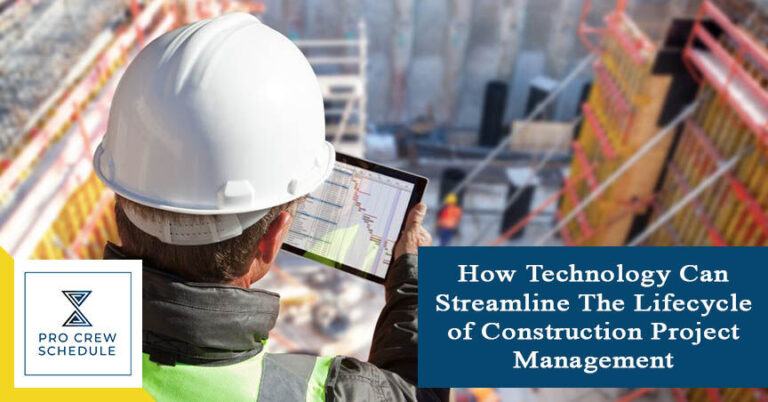When it comes to managing construction, some steps need to be taken in order to complete a project and deliver it on time and within budget. No matter the project’s size, scope, or complexity, it needs a good, efficient plan and someone who knows how to manage it and lead it to success. As a general contractor or project manager, you must clearly understand what your project demands and how to create the best plan. Building projects can vary in size, number of people involved, budget, and delivery date. But one thing is always the same: they are long, complex, and have many moving parts. This is why it is essential to have the right tools and techniques accessible to you to deliver the best value possible.
The detailed steps needed to finish a construction job are called the construction process. This process has five steps: planning and designing, preconstruction, procurement, building, and post-construction. Sometimes, each step is challenging because of the size and scope of the project.
The Five Steps in A Construction Project Management Lifecycle
In today’s world, there are many construction technologies and digital advancements that you can take advantage of. From management software to artificial intelligence (AI), machine learning (ML), or building information modeling (BIM), these technologies can help you streamline your process by automating tedious tasks and allow you to focus on the more essential, critical parts of project management.
As mentioned earlier, it is critical to have a clear idea of the construction project management lifecycle and how to keep it easier and faster to keep track of all project stages. In this section, let us discuss the five stages and how project management technology can help you manage things much easier and faster.
Initial Planning and Conceptualization
Most people overlook this part of the construction project management lifecycle and end up cramming and panicking during the latter parts of the project.
At the beginning of a construction job, not having clear goals is another big problem. Stakeholders in a project sometimes need to learn what they want or cannot agree on what materials to use. You can only manage a job well if the goals are clear.
In this stage, you must list everything you must do before a project is accepted and planning can start. It usually has three main subphases:
Feasibility Studies
The planning team outlines the project’s goals and aims using a viability study or business case. At this point, choices are made about the size of the building, the use of space, and the number of rooms needed. Once these choices have been made, a project start document (PID) is created.
Contracts and Documentations
These files contain the finished drawings and specifications. People who want to work on the project use these papers when bidding.
Communication and Collaboration
The biggest problem with starting a job on the right foot is that people must talk to each other. Project managers need to speak to the customer, the designer, the architect, the suppliers, and the engineers to develop the best design. This can only be done with a secure way to communicate.
Pre Construction
Once the bids are closed and a contractor is chosen to do the work, the next step is to assemble a project team to handle it.
At this point, a project team is getting the building site ready for construction. This could mean taking care of environmental issues like testing the soil. Once the site inspection is over, the city officials will review all the plans and results. After creating the strategic plan, budget, design, and schedule, the project team acquires the workers and materials it needs to start building.
If you do not have a clear picture of what the job will look like, how it will be done, and when it will be done, many unknown variables can arise. If all possible outcomes are not considered initially, the client may have unrealistic hopes. Preparing well enough raises the risk of problems and makes managing risks easier once the project begins.
Procurement
Next, the project team orders, buys, or rents all the tools, materials, and services needed to finish the project.
Whether this part of the building project is easy or hard depends on the size of the project, the available resources, and the date that the work starts.
Probably one of the biggest problems at this time is that people often need help understanding each other. The client may need to be more transparent about what they wanted, the contractor may have had to deal with shipping delays or ordering the wrong product, and the building manager may be stuck in the middle.
Construction
This is the part of the job where all the planning pays off. Project managers, design teams, and tech teams work hard to ensure project success before they even start building. When the building is done, the builder and subcontractors take center stage.
The construction manager and builder will oversee all communications and take the project from planning to completion. The architect, engineers, and project manager will check the work for quality control, answer requests for information (RFIs), and review and accept technical submissions. The most important thing is to ensure that the contractor completes the job as planned.
Construction should go smoothly if the project team carefully completes the planning and preconstruction stages. However, even when everything is planned out well, problems can arise.
Problems with organizing happen frequently now. One construction team may have to wait for another team to finish their part of the job because most physical construction occurs in a straight line. Each person may also make their own hours. Various delays and price overruns can happen when you plan and schedule poorly.
Post Construction
It takes a long time to plan and finish a building project, and the last step is the project closure phase. No more work is needed on the job site, so the project is over. The required resources are taken away, rented tools are returned, the work site is cleaned up, and workers who have finished their work move on to other projects.
From the project management perspective, the end of the project is a good time for a review. This could help identify unfinished tasks, investigate problems, and list valuable lessons for the future. Building jobs involves a lot of paperwork. One of the last things the project management team does is assemble all the project paperwork and give it to the owner.
Tips and Tricks On How To Manage Your Construction Project To Success
Even if you are a seasoned professional or a newbie in construction, you should know that it takes a lot of time, money, and effort to run it. It can be hard to keep up with everything when there are many moving parts, tight deadlines, and complicated tasks. But if you have the right plans, you can make your processes more efficient and ensure your job goes smoothly from beginning to end.
In this section, we will share a few tips and tricks on how you can manage to succeed.
Establish Clear Goals and Objectives
The first thing that you should do is to set clear goals and objectives. Set clear, SMART goals for the project, each with reasonable due dates and specific outcomes. A clear road map will help your team stay on track, monitor each activity, and ensure everyone is working toward the same goal.
Create A Detailed Plan
A well-thought-out plan is essential for a successful construction job. Please take note of all your activities and break them down into smaller, workable tasks. Next, set due dates for each step and ensure that resources are used correctly. Try to plan for delays or problems that could happen and have backups ready to lower your risks.
Communicate Closely with Your Team
Managing a construction job well depends on how well people can talk to each other. A construction project involves thousands of moving parts, and you must speak to many people. Tell everyone with a stake in the project about changes, goals, and progress. To make sure everyone is on the same page, set up regular ways to talk, like digital tools or meetings once a week.
Utilize Technologies
Technology can make managing building projects much easier today. Check out scheduling apps, project management software, and mobile apps that can help you streamline your work, facilitate collaboration, and get more done.
Prioritize Safety
Safety should always come first in construction projects. Due to its dangerous, volatile nature, the construction industry has one of the highest fatality rates. Set strong safety rules, ensure workers have the proper training, and conduct regular inspections to find and fix possible hazards. By making the workplace safe, you can reduce crashes and injuries and ensure everyone on your team is healthy.
Monitor The Project
Keep a close eye on how the project is going and often check the key performance indicators. Keep an eye on budget spending, resource allocation, and goals to spot any changes from the plan early on. Quickly deal with problems and make necessary changes to keep the job on track.
Foster Collaboration
Many people, like architects, engineers, builders, and subcontractors, are involved in building projects. Spread a spirit of mutual respect and cooperation, encourage open conversation, and transparently share information.
Review and Evaluate Changes
Being flexible is very important when managing a construction job. Be ready to change your plans if the project’s goals, timeline, or needs change. Stay flexible and open to the evolving needs, and take the initiative to deal with any problems that come up along the way.
How Construction Management Software Can Help You
Technology has made a massive difference in how construction plans are made. Construction project management software, Pro Crew Schedule, lets project managers and other essential people see what problems might arise so they can start working on solutions before the project begins.
When all the information from all the different parties is put in one place, mistakes are less likely to happen, and everyone on the team is on the same page. It also provides a platform that connects everyone, whether at the office or in the field.
Using software also makes it easy for teams to work together immediately by giving them mobile access to contract papers, framework agreements, and spending data. With automated reviews, your schedule changes as your project does.
Key Takeaway
To sum up, running construction projects smoothly and quickly requires careful planning, good communication, and a dedication to always getting better. Using these tips and strategies, you can make your processes more efficient, lower risks, and ensure your building projects succeed.







